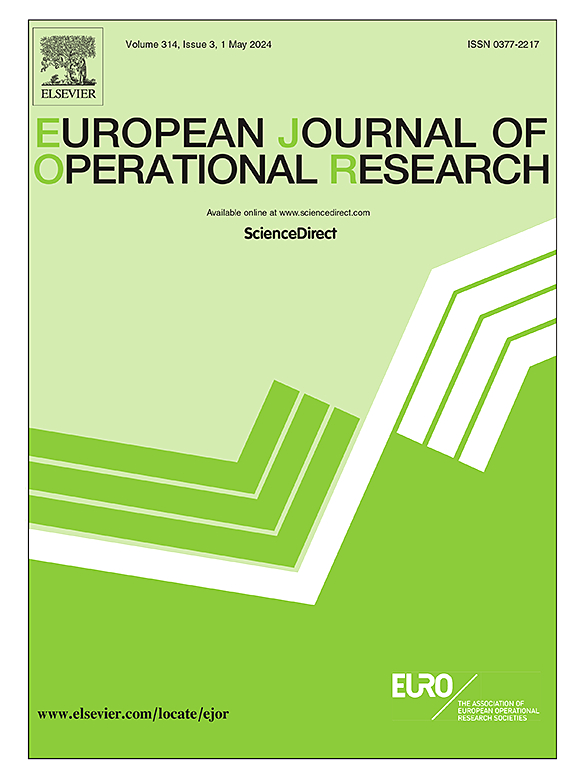Hub location problem with a mixed green fleet
IF 6
2区 管理学
Q1 OPERATIONS RESEARCH & MANAGEMENT SCIENCE
引用次数: 0
Abstract
This study presents a new strategic hub location problem with a mixed fleet of vehicles, including diesel-based vehicles, electric vehicles, and unmanned aerial vehicles. Each vehicle type has a different cost structure, payload capacity, and traveling range. The objective function minimizes the sum of the recharging (or refueling) cost, driver cost, fixed vehicle cost, and waiting cost for vehicles and drivers at recharging stations. While the transportation cost (including the recharging cost, driver cost, and vehicle cost) depends on the traveled distance, the recharging fee and waiting cost depend on the number of visits to recharging stations. We develop a mixed-integer linear programming formulation with preprocessing rules and also propose a relax-and-fix heuristic approach. The computational experiments are conducted over well-known CAB and TR data sets, and also a new German data set. The computational results evaluate the performance of the relax-and-fix heuristics and analyze the impact of varying fuel prices, limits on the use of vehicle types, different fleet compositions, different cost structures, and a hypothetical drone with a larger payload capacity and a longer flying range. Results show how the optimal fleet mix, in particular the use of electric vehicles and drones, and the optimal network vary around the world, as these depend on the geographic scope of the services, the distribution of nodes and arc lengths, and the relative costs for fuel (electricity or diesel).混合绿色舰队的枢纽位置问题
本研究提出了一个新的战略枢纽定位问题,其中包括混合车辆,包括柴油车辆,电动车辆和无人驾驶飞行器。每种车辆类型都有不同的成本结构、有效载荷能力和行驶里程。目标函数使充电站的充电(或加油)成本、驾驶员成本、固定车辆成本、车辆和驾驶员等待成本之和最小。而交通成本(包括充电成本、司机成本和车辆成本)取决于行驶距离,充电费用和等待成本取决于充电站的访问次数。我们开发了一个带有预处理规则的混合整数线性规划公式,并提出了一种松弛修复启发式方法。在著名的CAB和TR数据集以及一个新的德国数据集上进行了计算实验。计算结果评估了放松-修复启发式算法的性能,并分析了不同燃料价格、车辆类型限制、不同机队组成、不同成本结构以及具有更大有效载荷能力和更长的飞行距离的假设无人机的影响。结果显示了最佳车队组合,特别是电动汽车和无人机的使用,以及最佳网络在世界各地的变化,因为这些取决于服务的地理范围、节点分布和弧长,以及燃料(电力或柴油)的相对成本。
本文章由计算机程序翻译,如有差异,请以英文原文为准。
求助全文
约1分钟内获得全文
求助全文
来源期刊

European Journal of Operational Research
管理科学-运筹学与管理科学
CiteScore
11.90
自引率
9.40%
发文量
786
审稿时长
8.2 months
期刊介绍:
The European Journal of Operational Research (EJOR) publishes high quality, original papers that contribute to the methodology of operational research (OR) and to the practice of decision making.
 求助内容:
求助内容: 应助结果提醒方式:
应助结果提醒方式:


